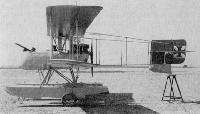
Описание
Страна: Германия
Год: 1914
Варианты
- Friedrichshafen - FF27 - 1914 - Германия
- Friedrichshafen - FF31 - 1914 - Германия
- Friedrichshafen - FF37 - 1916 - Германия
- O.Thetford, P.Gray German Aircraft of the First World War (Putnam)
- J.Herris Friedrichshafen Aircraft of WWI (A Centennial Perspective on Great War Airplanes 21)
- Журнал Flight
-
J.Herris - Friedrichshafen Aircraft of WWI /Centennial Perspective/ (21)
Friedrichshafen FF31 Marine Number 275.
-
O.Thetford, P.Gray - German Aircraft of the First World War /Putnam/
Friedrichshafen FF 31
-
J.Herris - Friedrichshafen Aircraft of WWI /Centennial Perspective/ (21)
Friedrichshafen FF31 Marine Number 275.
-
M.Dusing - German Aviation Industry in WWI. Volume 2 /Centennial Perspective/ (85)
Fdh FF31 (1915). Also in service with the Imperial Navy were two space fraim biplanes (Navy numbers 274 and 275), each equipped with a 160 hp Maybach Mb.III engine. The first flight took place on April 12, 1915. The two aircraft were not used at the front. This was a last attempt with a rear-mounted, pusher engine.
-
J.Herris - Friedrichshafen Aircraft of WWI /Centennial Perspective/ (21)
Friedrichshafen FF31 Marine Number 274 was one of only two FF31 aircraft built, the other being MN 275.
-
J.Herris - Friedrichshafen Aircraft of WWI /Centennial Perspective/ (21)
Friedrichshafen FF31 SVK Drawing
O.Thetford, P.Gray German Aircraft of the First World War (Putnam)
Friedrichshafen FF 31
Only two FF 31 seaplanes were built (Nos. 274 and 275), and they were delivered to the German Navy in May 1915. No. 275 is illustrated. Span, 16.85 m. (55 ft. 3 3/8 in.). Length, 10.15 m. (33 ft. 3 5/8 in.). Height, 3.9 m. (12 ft. 9 5/8 in.). Area, 60 sq.m. (648 sq.ft.). Weights: Empty, 1,040 kg. (2,288 1b.). Loaded, 1,530 kg. (3,366 lb.). Speed, 98 km.hr. (61.25 m.p.h.). Armament, one manually operated Parabellum machine-gun.
Описание:






